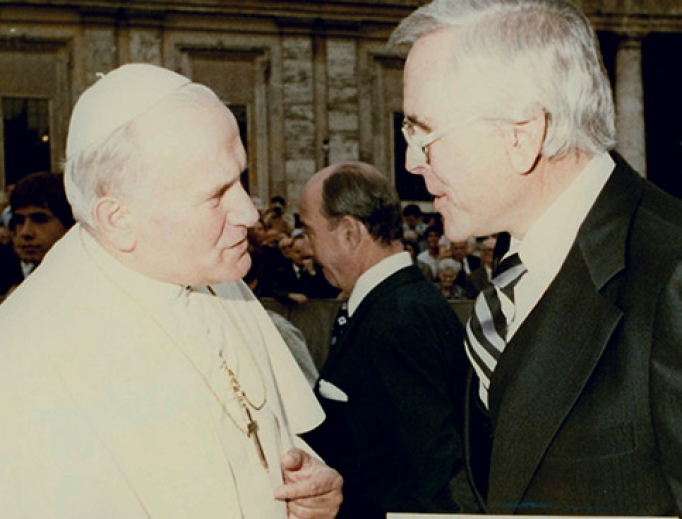Christ Cathedral’s Transformation Is an Act of Providence
COMMENTARY: The project also reflects a renewed sense of mission for the Diocese of Orange, California.

GARDEN GROVE, Calif. — The July 17 dedication of the new Christ Cathedral for the Diocese of Orange looked backward and forward: backward to discerning the providence of God at work in the unusual conversion of a Protestant televangelist’s iconic church — the Crystal Cathedral — into a Catholic cathedral; and forward to a renewed sense of mission for the diocese organized around the new cathedral.
When Robert Schuller’s Hour of Power television ministry built its new home in 1982, the name “Crystal Cathedral” became widely popular, which was odd, because Protestants of the Schuller variety do not have cathedrals. Cathedrals are for churches that have bishops.
It’s true that the term “cathedral” — derived from cathedra, the Latin word for “seat,” referencing the bishop’s throne in the church — is mistakenly used to describe any grand church, but Schuller certainly knew better. It’s likely that he was not too bothered by the episcopal connotations of calling his church a “cathedral” because Schuller was rather friendly toward Catholics; though his ministry did not have an overseeing bishop, he was not opposed in principle to that reality in the Christian tradition.
During the dedication ceremonies, there was an occasional reference to a photograph from 1980, in which Schuller is greeted by St. John Paul II at a general audience in Rome. He has the plans for Crystal Cathedral with him, and he shows them to the Holy Father. In retrospect, some suggested that John Paul’s blessings upon the plans gave a glimpse at what the future held for Crystal Cathedral.

Greetings at general audiences do not usually allow for much other than pleasant greetings. But the photograph is a symbol of a deep conviction in the diocese that only Providence could explain the highly unusual path that led the bankrupt television ministry to sell its property and buildings to the Catholic diocese.
Bishop Kevin Vann of Orange, California, opened his homily at the dedication Mass with a simple declaration that what was taking place was an “act of Providence.”
And it is hard to argue. A building called a “cathedral” when it wasn’t one, and couldn’t be one, now is one.
There was another sense of Providence at work in the Christ Cathedral project. In the history of sacred architecture, what might be called “secular” styles have been taken up and “converted” to sacred use. One can find there a Providential thread in history; even designs not intended for God eventually find their fulfillment in rendering him glory.
This was evident in the early Christians’ adaptation of the basilica style, which Romans used for public meetings. We now use the term “basilica” for churches of particular importance; it has lost its secular meaning and become entirely an ecclesial term.
Rome has other examples of specific churches being converted to sacred use. The most famous is the Pantheon, the masterpiece of Roman imperial architecture that was converted to a church in honor of St. Mary and the Martyrs. The exterior was left intact — indeed, one of the best-preserved imperial buildings in Rome — but the interior was transformed into a church. A later example is the Church of St. Mary of the Angels near the main Roman railway station, the site of ruins of Roman baths. Michelangelo built a church inside them.
One might think also of the cathedral of Rome, St. John Lateran. The massive bronze doors of the basilica once were the doors of the Senate House during the reign of the Roman emperors. Everything else from the Roman Forum is in ruins; only the doors are still used for their original purpose because they were taken up and given new life by the Church.
At the dedication Mass, Bishop Vann quoted Benedict XVI, who gave several learned addresses on the language of cathedrals, most notably at St. Patrick’s in New York in April 2008 and at Notre Dame in Paris in September of the same year.
At a general audience in 2009, Benedict noted that the development of Gothic designs introduced “two new characteristics in comparison with the Romanesque, a soaring upward movement and luminosity. … The upward thrust was intended as an invitation to prayer and at the same time was itself a prayer.”
Height and luminosity are abundant at the new Christ Cathedral. It might seem a bit of a stretch to apply examples from the ancient or medieval world to a building not yet 40 years old, but it is not too soon to ask whether a similar dynamic is repeating itself for the media age in Garden Grove.
The boldness of the Christ Cathedral project was matched by a confidence about the future of the entire cathedral campus, which includes a “Tower of Hope” that houses several new Catholic institutes — including EWTN’s West Coast studio — and a cultural center that is currently hosting an exhibition on the Sistine Chapel.
“[Christ] Cathedral will be the epicenter of Catholicism on the West Coast, serving not only as a place of worship, but faith formation, evangelization, charitable work, art and culture,” declared a special edition of the Orange County Catholic newspaper.
“Epicenter” might be an odd word choice for California, but nonetheless the Christ Cathedral project has a forward-looking evangelical thrust. This is not a work of architectural preservation, or even a smart real estate investment. It reflects a confidence that what Providence wrought in delivering Christ Cathedral to this new beginning is reason for confidence about how Providence will work now that the cathedral is ready for use.
Father Raymond J. de Souza is the editor in chief of Convivium magazine.
















